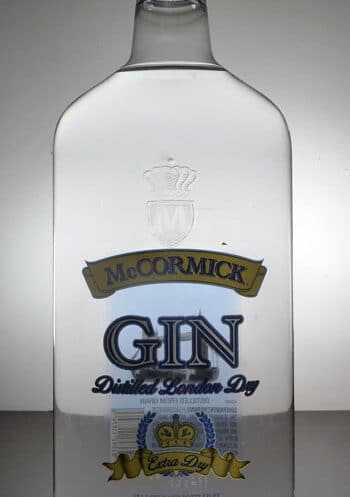Reader John wrote to us:
First of all, thanks for creating this site! I’ve loaded it on my mobile device many a time while perusing the closest liquor store with a good gin selection (nearly 100 miles away).
Anyhow, I was wondering if you have tried McCormick Gin. It’s a bottom-shelf gin, priced at ~$8 per 750 mL. It was one of my first gins and I believe it is underrated. However, I’m interested in your take.
Thanks for writing John! And thank you for the compliment. We’re excited to try the gin and offer up a review for it. Looking around the web doing some research for this review, I was impressed how little was out there about McCormick Gin. The McCormick Distilling Company is located in Weston, Missouri. They don’t even provide additional information about the spirit on their website, aside from “yes, we make a gin!.” The back of the bottle informs us that the base spirit is grain. The distillery itself is one of the oldest in the US: in operation since 1856, though one of the first mentions we find of their gin is in the 1947 Joplin Post. By the 1960’s they were advertising for it in Albuquerque, Galveston and other Western cities. It was recently cites as among the top 10 selling gins in the U.S., and at times has been listed as #2 behind Fleischmann’s. In short, it’s much more common than a preliminary search on the net might reveal. Why has no one else cover it yet?
Well let us take care of it. Thanks for asking us John. As usual, we review it as if any other gin. We tried it in 4 cocktails and on its own to try and understand what makes McCormick Gin tick.
Tasting Notes
On the nose, pine accentuated juniper, with toasted ground coriander, loudly declaring itself on the nose. McCormick Gin is clearly classic styled from first aroma, though the heavy coriander will readily distinguish it from other London Dry or Classic Styled gins.
The palate is literal and true to the nose. You get that first taste of pine-accent juniper. Brisk and oily, quickly ushered aside by a heavy dose of coriander in the middle. The coriander is dusty, cooked, and has a slight peppery lift, like the aroma of fresh cracked white pepper without the exotic character. Towards the finish, dry spice, with the juniper taking on a slightly more resiny dry tone. Late, there’s orris underneath the coriander, with hints of crisp angelica but also a bracing note of ethanol which becomes one of the dominant notes on the finish. Although a lot of other notes make themselves known, the combination of coriander and juniper is generally traditional in profile.
Cocktails
First we tried it in a White Lady. A classic dating back to just before prohibition, the official recipe is 4 parts gin, 3 parts Cointreau and 2 parts fresh lemon juice. The 1919 original used egg white; the modern version omit it. Citrus, bright lemon and orange rinds, with a hint of pine. It’s mostly orange candy up front, with coriander on spice on the back. Zested orange takes over the finish. Clean and bright, with the gin coming through in the middle most clearly.
Next, we tried it in a Moonlight cocktail. The violet and orange pushed forward a sweet candy like side of the drink. There’s a touch of spice hovering in the distant background, but we were looking for the gin. Where was it? It was largely hidden beneath a couple very strong co-stars. McCormick Gin, although assertive on its own, isn’t as much so in a cocktail such as this. Though it seems that the violet and orange notes come through at the same point on the palate the coriander did. As the dominant flavor of the gin, it seems to be more a case of everything shouting at the same time.
Naturally we then mixed it up in a Gin and Tonic: Hansen’s tonic to be specific. Hansen’s is a little more citrus forward, so we omitted the lime. The citrus comes in early at first, where the gin is relatively quiet, but pine accented juniper delivers as a finish that only subtly highlights angelica and lemon rind comes in. It’s nice, refreshing, and classic
Cocktail from the Archives
And for McCormick Gin was looked to do something a little bit special. We unearthed a mostly forgotten cocktail. 1929’s Cocktails de Paris written by RIP a.k.a. Georges Gabriel Thenon. The Fandango cocktail is something of a curiosity. Gordon’s Gin is called by name throughout the book. Diluting it with vodka seems a curious step, and then there’s the Izarra jaune. Izarra is a French herbal spirit still being made today. I wish I could say I had a bottle on hand; however, others have suggested to substitute Yellow Chartreuse for Izarra. I trusted in their footsteps and made up a slight variation on the Fandango. Equal parts, but with the Chatreuse instead.
The Fandango was bewilderingly herbal up top. The Chartreuse dominates, but there’s parts where you start to get the gin more clearly. Sweet anise notes at first, then coriander, and juniper in the middle of the palate. Finish is strongly herbal with gentian and bracing, astringent wormwood lingering on an incredibly long finish.
Harsh and bracing as a cocktail; however, despite the strong co-stars, McCormick Gin added its perspective to the drink. As for the Fandango, I’m not sure what to make of it. With the Chartreuse so up front and center, I have to think that the substitution really defined the drink. I’m going to reserve judgement until I’m able to try it with Izarra Jaune. But for now, as it’s own thing, It’s an interesting drink, especially for those who enjoy a more bitter cocktail.
Overall, McCormick Gin
I spoke with a distiller who made an interesting observation. He said that “Americans really seem to like their coriander-forward gins.” There’s some truth to that it seems. When we did the 50 States of Gin tasting, we had noticed more than a couple “coriander bombs” on the table. McCormick is far from a bomb in that sense; however, the presence of that note: so integral to Bombay Sapphire does beg the question. Do we like the coriander flavor of our gin slightly more than our UK-loving gin friends?
In short, McCormick gin I think suffers from a couple of shortcomings. The ethanol flavor on the finish is a little rough, and the quality of the base spirit is a little less than what I might have hoped. It’s likely large scale NGS, and although that alone is not a predictor of the overall quality of the gin (yes, there are some quite good gins made with it), when combined with some of the very baked/over-cooked notes from the botanicals, it fails to rise too far above its station as a well-priced mixing gin.
Naturally, I don’t mean to judge anyone for their gin choices. John, I’m really excited that you asked me to take a look at this gin, which I’ve overlooked for too long. I think there’s a lot of things in here that I could see why they might appeal to someone. Let me make a couple of suggestions. One gin that I think has a lot in common with McCormick is Sacred’s Coriander Gin. You’ll taste some of the same notes in both gins; however, the distillation method of Sacred’s version preserves a clearer picture of the ingredient on the whole. It’s made with a similar spirit starting point, but the method for distilling the gin to give it the flavor is different. Sacred uses low temperature vacuum distillation, and therefore doesn’t “cook” the ingredients.
But at this price point, it’s actually quite acceptable. There are many other similarly bottled gins that lack any redeeming qualities. For inexpensive gins, I would say this is above average; but taking price out of the equation, there are better options out there.


Pales in contrast to some of the other economy gins. Okay in gin cocktail (e.g., gimlet), but not alone as in martini.
I had this gin last night for the first time. Actually it was in a Martini at an Italian Restaurant near Seattle. It was so enjoyable that two things happened:
A: I asked what gin did they use.
B: I had a second one just to verify 🍸
I tried Badger Claw Gin made in California. Tasted like diesel fuel mixed with nail polish remover to me.
If you like the taste of Juniper, you’ll probably like this one. I sure do. And the price is more than affordable. It works for me…
I am curious how you rate it vs Gordon’s. I cannot even get Mccormick gin in TN I don’t think, but we can get Mccormick Vodka and that is pretty wonderful so I am thinking their Gin might be good too. I like Gordon’s myself. How is it relative to that?
Since I do love Cilantro, wouldn’t this be a good gin for me? (Cilantro is Coriander)
Cilantro generally refers to the leaves and coriander the seeds. The seeds have quite a different flavor from the seeds. I would say it depends on your preference for the latter.
I recently went to a favorite restaurant and they had changed their normal “rail” gin to this McCormick Gin. To put it bluntly, my martini sucked so bad I didn’t finish it. I tried to – but after a few sips – it got worse, not better. So I basically left a 90% of a martini sitting in the table. I’ll remember to ask for a good gin by name next time